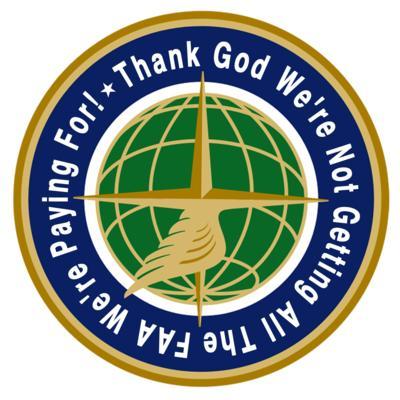Congressional Budget Office Proves AIRR Act Would Be A Budget Buster!
The nation's CBO says that H.R. 2997 would be costly -- as noted in the attached summary published late this week.
Summary:
H.R. 2997 would establish a federally chartered, not-for-profit corporation (known as the American Air Navigation Services (AANS) Corporation) to assume responsibility for operating the U.S. air traffic control system, a function currently performed by the Federal Aviation Administration (FAA). The proposed corporation would be governed by a 13-member board of directors composed of individuals representing certain aviation stakeholder groups. To finance the costs of providing air traffic services, the bill would authorize the corporation to charge fees to users of such services and to issue debt.

The Secretary of Transportation would manage and oversee the transition of operational control over air traffic services to the proposed corporation, which would occur on October 1, 2020. Until that time, the bill would authorize appropriations for the FAA to continue to operate, maintain, and modernize the air traffic control system and carry out the agency’s other traditional responsibilities related to civil aviation. After the proposed transition of all air traffic control-related personnel and programs to the AANS Corporation, the bill would authorize additional appropriations for FAA and the Department of Transportation (DOT) to continue to meet traditional aviation-related responsibilities, such as performing certain regulatory and safety-related activities, making grants to airports to support capital projects, and subsidizing air service to certain rural communities.
Although the proposed corporation would be independent and autonomous, in CBO’s view it would effectively act as an agent of the federal government in carrying out a regulatory function. Hence, in keeping with guidance specified by the 1967 President’s Commission on Budget Concepts, the proposed corporation’s cash flows should be recorded in the federal budget. More specifically, fees charged by the proposed corporation should be recorded as federal revenues, and its expenditures should be classified as federal direct spending.
On that basis, CBO estimates that enacting H.R. 2997 would:
- Increase net direct spending by $90.7 billion over the 2018-2027 period;
- Increase net revenues by $70.0 billion over the 2018-2027 period;
- Increase net deficits stemming from revenues and direct spending by about $20.7 billion over the 2018-2027 period; and
- Result in discretionary outlays totaling $52.3 billion over the 2018-2027 period, subject to the appropriation of authorized amounts.
Pay-as-you-go procedures apply because enacting the legislation would affect direct spending and revenues. CBO estimates that enacting H.R. 2997 would increase net direct spending and on-budget deficits by more than $5 billion in one or more of the four consecutive 10-year periods beginning in 2028.

The estimated changes in direct spending and revenues under H.R. 2997 reflect CBO’s assessment of the budgetary effects of enacting H.R. 2997 as a stand-alone measure. Ultimately, however, the net budgetary impact of activities related to air traffic control under H.R. 2997 would depend on the details of additional legislation that lies beyond the scope of this cost estimate. H.R. 2997 does not address other important aspects of federal activities related to aviation—in particular, provisions of current law that govern aviation-related excise taxes that cover most of the FAA’s costs related to air traffic services and other programs. Similarly, although H.R. 2997 authorizes a marked reduction in future appropriations for the FAA that comport with the envisioned transfer of operational control over the air traffic control system to the AANS Corporation, whether subsequent reductions in future discretionary funding for the agency occur would depend on appropriations enacted by future
Congresses. As a result, the ultimate net budgetary impact of corporatizing air traffic control under H.R. 2997 could differ considerably from the estimates presented in this analysis, but CBO cannot provide an analysis of such potential impacts because they would depend on the details of future legislation (see the discussion below under the heading “Additional Information”).
H.R. 2997 would impose intergovernmental and private-sector mandates as defined in the Unfunded Mandates Reform Act (UMRA) on operators of air ambulances. The bill also would preempt state authority over air traffic control services. Based on information from the FAA, public airport operators, and state aviation agencies, CBO estimates that the cost of the mandates on public entities would fall below the annual threshold established in UMRA for intergovernmental mandates ($78 million in 2017, adjusted annually for inflation). The bill would impose additional mandates on private entities including users of air traffic services, air carriers, manufacturers of aircraft, and ticket agents. CBO estimates that the aggregate cost of mandates on private entities would well exceed the annual threshold established in UMRA for private-sector mandates ($156 million in 2017, adjusted annually for inflation).
 ANN's Daily Aero-Term (04.24.24): Runway Lead-in Light System
ANN's Daily Aero-Term (04.24.24): Runway Lead-in Light System ANN's Daily Aero-Linx (04.24.24)
ANN's Daily Aero-Linx (04.24.24) Aero-FAQ: Dave Juwel's Aviation Marketing Stories -- ITBOA BNITBOB
Aero-FAQ: Dave Juwel's Aviation Marketing Stories -- ITBOA BNITBOB Classic Aero-TV: Best Seat in The House -- 'Inside' The AeroShell Aerobatic Team
Classic Aero-TV: Best Seat in The House -- 'Inside' The AeroShell Aerobatic Team Airborne Affordable Flyers 04.18.24: CarbonCub UL, Fisher, Affordable Flyer Expo
Airborne Affordable Flyers 04.18.24: CarbonCub UL, Fisher, Affordable Flyer Expo




